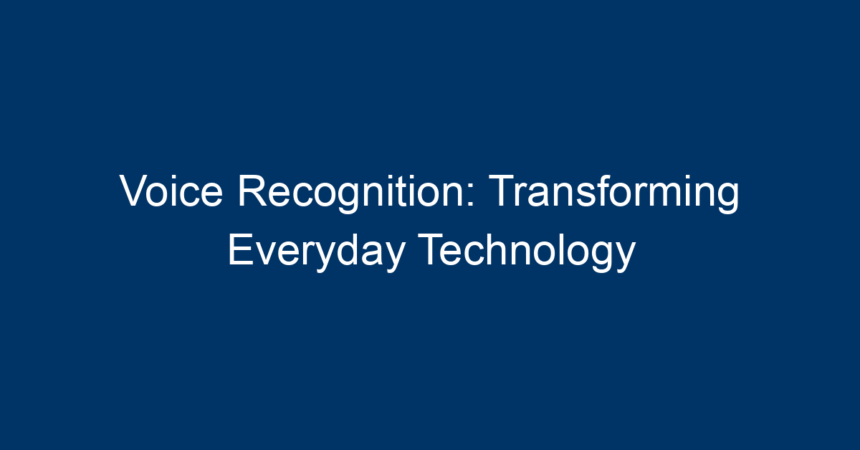In recent years, voice recognition technology has shifted from science fiction to an integral part of our daily lives. From smart assistants like Siri and Alexa to voice-activated systems in cars, the way we interact with technology has been revolutionized. This article explores how voice recognition is transforming everyday experiences, enhancing convenience, accessibility, and efficiency. We’ll delve into its applications, the underlying technologies, and what the future holds for this ever-evolving technology.
What is Voice Recognition?
Voice recognition, or speech recognition, is the ability of a machine or program to identify and process human speech. It converts spoken language into text, enabling devices to understand and respond to voice commands. This technology relies on advanced algorithms, machine learning, and artificial intelligence to continually improve its accuracy and functionality.
The Evolution of Voice Recognition Technology
The journey of voice recognition dates back to the 1950s, with early systems capable of understanding only limited vocabularies. The technology has since advanced significantly, driven by improvements in computing power and data availability. Today’s voice recognition systems use neural networks and deep learning techniques, making them remarkably accurate in diverse environments.
Applications of Voice Recognition
The impact of voice recognition is felt across various sectors. Here, we explore some of the most prominent applications:
1. Smart Home Devices
Voice recognition technology has brought about a new era of smart home management. Devices like Amazon Echo and Google Home allow users to control lighting, temperature, and even security systems with simple voice commands. This not only enhances convenience but also enables users to perform tasks hands-free, making daily routines smoother.
2. Healthcare
In the healthcare sector, voice recognition is streamlining documentation and improving patient care. Medical professionals use voice-to-text systems to efficiently update patient records, write prescriptions, and communicate with colleagues. This technology reduces the administrative burden on healthcare workers, allowing them to focus more on patient interaction.
3. Automotive Industry
Voice recognition is increasingly becoming a staple in modern vehicles. Drivers can control navigation, make phone calls, and change music simply by speaking. This hands-free technology promotes safer driving by minimizing distractions, allowing drivers to keep their eyes on the road.
4. Customer Service
Many businesses have adopted voice recognition systems in their customer service strategies. Automated voice response systems streamline interactions and reduce wait times. These systems can handle routine inquiries efficiently, allowing human agents to focus on more complex issues.
5. Accessibility
For individuals with disabilities, voice recognition is a game changer. It allows for easier interaction with computers and mobile devices, enabling those who may have limited mobility to access technology independently. Software that translates spoken words into text helps bridge communication gaps, fostering inclusivity.
How Voice Recognition Works
Understanding the technology behind voice recognition is key to appreciating its capabilities. Here’s a simplified breakdown of how it works:
1. Audio Input
When a user speaks, their voice is captured by a microphone. This audio input is then converted into a digital signal that can be processed by the computer.
2. Signal Processing
The digital signal is analyzed using algorithms that identify phonetic sounds and patterns. This stage involves breaking down the audio into smaller units, or phonemes, which represent the fundamental sounds of speech.
3. Feature Extraction
In this phase, the system extracts relevant features from the audio signal, such as pitch, volume, and tempo. This information helps the system better understand the distinct characteristics of the speaker’s voice.
4. Pattern Recognition
Machine learning models, specifically neural networks, compare the extracted features against a vast database of spoken words. Through continuous training, these models improve their ability to recognize different accents, speech patterns, and variations in pronunciation.
5. Output Generation
Finally, the recognized words are translated into text or executed as commands, allowing the device to respond appropriately. This whole process occurs in mere milliseconds, making voice recognition appear instantaneous.
Challenges Facing Voice Recognition
Despite its advancements, voice recognition technology faces several challenges:
1. Accents and Dialects
Variability in speech patterns can hinder accuracy. While modern systems have made strides in handling different accents, some still struggle with regional dialects, which can lead to misinterpretation.
2. Background Noise
Voice recognition is often less effective in noisy environments. Disturbances can drown out the speaker’s voice, leading to errors in recognition.
3. Privacy Concerns
With the rise of voice-activated devices, concerns about privacy and data security have escalated. Users often wonder how their voice data is stored and used, leading to a demand for greater transparency from tech companies.
4. Dependency on Internet Connectivity
While some systems work offline, many voice recognition applications require an internet connection to process data effectively. This dependency can limit functionality in areas with poor connectivity.
The Future of Voice Recognition
As technology continues to evolve, voice recognition is poised to become even more integrated into our lives. Here are some trends to watch:
Enhanced Personalization
Future voice recognition systems will likely be able to recognize individual voices and personalize responses accordingly. This will create a more tailored user experience, adapting to preferences and habits.
Improved Accuracy
With advancements in artificial intelligence and machine learning, we can expect even more accurate voice recognition. Systems will continuously learn and adapt, minimizing errors in diverse environments.
Multilingual Capabilities
As global communication expands, the demand for multilingual voice recognition will grow. Future systems will likely support real-time translation, allowing seamless conversation across different languages.
Increased Integration with Augmented and Virtual Reality
Voice recognition will play a significant role in enhancing interactive experiences in augmented (AR) and virtual reality (VR). As these technologies mature, the ability to control digital environments through voice commands will undoubtedly enrich user interaction.
Actionable Insights for Users and Businesses
Here are some tips and insights for users and businesses looking to incorporate voice recognition into their daily lives and operations:
-
Explore Devices: Experiment with various smart home devices to find the best fit for your needs. Consider voice-activated lighting, heating, and security systems to enhance convenience.
-
Utilize Voice Assistants: Leverage voice assistants for everyday tasks, such as setting reminders, making shopping lists, and playing music. This hands-free interaction can save time and streamline your day.
-
Invest in Quality: For businesses, investing in high-quality voice recognition systems can enhance customer satisfaction. Ensure your systems are robust enough to handle the frequency of inquiries while providing accurate responses.
-
Stay Informed: Keep up with the latest trends in voice recognition technology. As advancements emerge, being aware of new features or applications can help maximize the benefits for personal or business use.
- Educate Your Team: For organizations, training employees on using voice recognition tools can boost productivity. Promote awareness of how these technologies can improve workflow and efficiency.
Conclusion
Voice recognition technology is undeniably transforming the way we interact with our environments. As it continues to evolve, its potential to enhance convenience, accessibility, and efficiency is limitless. Embracing this technology can lead not only to improved personal experiences but also to greater business efficiencies. By staying informed and adapting to these changes, users and businesses alike can harness the power of voice recognition to drive innovation and success in their daily lives.




